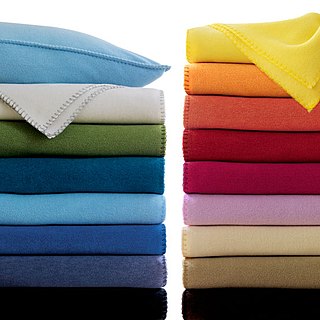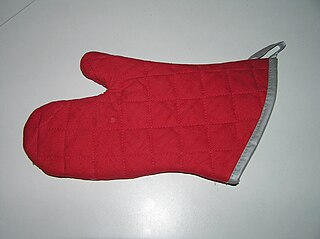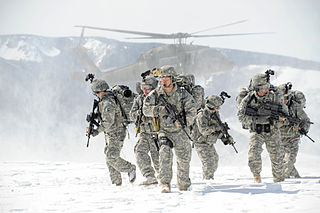
Wool is the textile fibre obtained from sheep and other animals, including cashmere and mohair from goats, qiviut from muskoxen, hide and fur clothing from bison, angora from rabbits, and other types of wool from camelids.

Extreme cold weather clothing refers to clothing for arctic or mountainous areas. Its primary function is to trap air as an insulator to prevent heat loss from the wearer's body. Secondary and necessary is to conduct water vapor away from the body to keep the insulating layers dry. A shell keeps the wind from disturbing the still air in the insulating layers. In warmer conditions, the shell protects from water intrusion.

Nomex is a flame-resistant meta-aramid material developed in the early 1960s by DuPont and first marketed in 1967.

A ski suit is a suit made to be worn over the rest of the clothes when skiing or snowboarding. A ski suit made for more casual winter wear outdoors may also be called a snowsuit [ˈsnoʊˌsut] and are often used by children as everyday outerwear in the winter season. Some suits are specifically made for snowboarders but most are used by either skiers or snowboarders regardless of the style.

Thinsulate is a brand of synthetic fiber thermal insulation used in clothing. The word is a portmanteau of the words thin and insulate, trademarked by 3M. The material is made by the 3M Corporation and was first sold in 1979. It was originally marketed as an inexpensive alternative to down; at the time, 3M claimed it was twice as warm as an equivalent amount of any natural material.

Waterproof fabrics are fabrics that are, inherently, or have been treated to become, resistant to penetration by water and wetting. The term "waterproof" refers to conformance to a governing specification and specific conditions of a laboratory test method. They are usually natural or synthetic fabrics that are laminated to or coated with a waterproofing material such as rubber, polyvinyl chloride (PVC), polyurethane (PU), silicone elastomer, fluoropolymers, and wax. Treatment could be either of the fabric during manufacture or of completed products after manufacture, for instance by a waterproofing spray. Examples include the rubberized fabric used in Mackintosh jackets, sauna suits and inflatable boats.

SympaTex is a type of fabric that is branded as waterproof but "breathable", made or licensed by SympaTex Technologies GmbH a company founded in 1986. The fabric features a waterproof, windproof and breatheable membrane that is laminated to fabrics either on its inner surface or sandwiched between two fabric layers. The latter system offers greater durability, by better protecting the integrity of the SympaTex layer from abrasion to both the outside and the inside of the garment.
Windstopper is a windproof breathable fabric laminate made by W. L. Gore & Associates. One of its most common applications is a lamination with polar fleece, to compensate for fleece's lack of wind resistance.

Polar fleece is a soft napped insulating fabric made from polyester.

An oven glove, or oven mitt, is an insulated glove or mitten usually worn in the kitchen to easily protect the wearer's hand from hot objects such as ovens, stoves, cookware, etc. They are similar to pot-holders.

Bunker gear is the personal protective equipment (PPE) used by firefighters. The term can refer, depending on the context, to just the trousers, boots and jacket, or to the entire combination of protective clothing. The terms are derived from the fact that the trousers and boots are traditionally kept by the firefighter's bunk at the fire station to be readily available for use.
Layered clothing is a term describing a way of dressing using many garments that are worn on top of each other. Some of the layers have different, largely non-overlapping, functions. Using more or fewer layers, or replacing one layer but not others, allows for flexible clothing to match the needs of each situation. Two thin layers can be warmer yet lighter than one thick layer, because the air trapped between layers serves as thermal insulation. Layered clothing is particularly relevant in cold climates, where clothing must at the same time transfer moisture, provide warmth, and protect from wind and rain. In a hot and dry climate, clothes have very different functional requirements: they must block the radiation from the sun, and allow for sufficient air circulation. Therefore, layered clothing in the sense used in this article is largely irrelevant in hot and dry climates. The wicking layer moves the sweat from your skin, where it can be absorbed by the other layers.

An (Integrated) Thermal Micrometeoroid Garment is the outer layer of a space suit. The TMG has three functions: to insulate the suit occupant and prevent heat loss, to shield the occupant from harmful solar radiation, and to protect the astronaut from micrometeoroids and other orbital debris, which could puncture the suit and depressurize it.

The Extended Cold Weather Clothing System is a protective clothing system developed in the 1980s by the United States Army Natick Soldier Research, Development and Engineering Center, Natick, Massachusetts. The first generation ECWCS consisted of parka and trousers plus 20 other individual clothing, handwear, headwear and footwear items which are used in various combinations to meet the cold weather environmental requirements of the US military. The Gen III ECWCS is designed to maintain adequate environmental protection in temperatures ranging between -60 and +40 Fahrenheit

The Army Combat Shirt (ACS) is a flame-resistant shirt developed and used by the United States Army as a supplementary addition to the Army Combat Uniform. The ACS is a stand-alone shirt designed specifically for use with Improved Outer Tactical Vest armor in warm and hot weather instead of the blouse. It is intended to greatly increase user comfort through the use of lightweight, moisture-wicking, and breathable fabrics. The ACS was created in conjunction with the USMC's Flame Resistant Organizational Gear (FROG). The ACS, in conjunction with the Fire Resistant ACU (FRACU) trousers, provides head-to-toe protection against burns.
Nikwax Analogy is a two-component fabric system for weatherproof clothing based on "biomimicry" of fur.

Lopi is knitting wool made from the fleece of Icelandic sheep. The fleece is made up of two layers, each with a different kind of wool. The wet-resistant outer coat contains long, coarse fibres, while the insulating layer beneath consists of soft, short fibres. These are processed together to create lopi roving and yarn.

In sewing and tailoring, a lining is an inner layer of fabric, fur, or other material inserted into clothing, hats, luggage, curtains, handbags and similar items.
NORN is a winter trouser manufacturer based in Montreal, Canada. The insulating fabric for the pants is a special type of fleece. The outer layer is either wool, poly-wool blend or polyester. The combination of the fabrics is chosen such that the pants breathe but also insulates. The main idea is to be warm when out side, while remaining comfortable indoors.

A racing suit or racing overalls, often referred to as a fire suit due to its fire retardant properties, is clothing such as overalls worn in various forms of auto racing by racing drivers, crew members who work on the vehicles during races, track safety workers or marshals, and in some series commentators at the event.
















